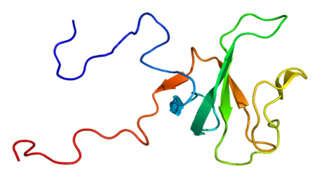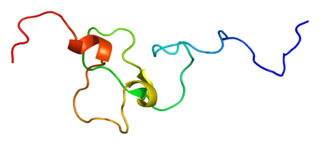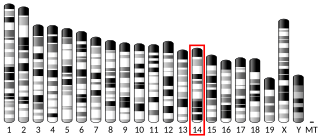Related Research Articles

Phosphatase and tensin homolog (PTEN) is a protein that, in humans, is encoded by the PTEN gene. Mutations of this gene are a step in the development of many cancers, specifically glioblastoma, lung cancer, breast cancer, and prostate cancer. Genes corresponding to PTEN (orthologs) have been identified in most mammals for which complete genome data are available.

Merlin is a cytoskeletal protein. In humans, it is a tumor suppressor protein involved in neurofibromatosis type II. Sequence data reveal its similarity to the ERM protein family.

The nuclear receptor co-repressor 1 also known as thyroid-hormone- and retinoic-acid-receptor-associated co-repressor 1 (TRAC-1) is a protein that in humans is encoded by the NCOR1 gene.

The nuclear receptor co-repressor 2 (NCOR2) is a transcriptional coregulatory protein that contains several nuclear receptor-interacting domains. In addition, NCOR2 appears to recruit histone deacetylases to DNA promoter regions. Hence NCOR2 assists nuclear receptors in the down regulation of target gene expression. NCOR2 is also referred to as a silencing mediator for retinoid or thyroid-hormone receptors (SMRT) or T3 receptor-associating cofactor 1 (TRAC-1).

Tumor suppressor p53-binding protein 1 also known as p53-binding protein 1 or 53BP1 is a protein that in humans is encoded by the TP53BP1 gene.

Metastasis-associated protein MTA1 is a protein that in humans is encoded by the MTA1 gene. MTA1 is the founding member of the MTA family of genes. MTA1 is primarily localized in the nucleus but also found to be distributed in the extra-nuclear compartments. MTA1 is a component of several chromatin remodeling complexes including the nucleosome remodeling and deacetylation complex (NuRD). MTA1 regulates gene expression by functioning as a coregulator to integrate DNA-interacting factors to gene activity. MTA1 participates in physiological functions in the normal and cancer cells. MTA1 is one of the most upregulated proteins in human cancer and associates with cancer progression, aggressive phenotypes, and poor prognosis of cancer patients.

CYLD lysine 63 deubiquitinase, also known as CYLD, is a human gene.

COP9 signalosome complex subunit 2 is a protein that in humans is encoded by the COPS2 gene. It encodes a subunit of the COP9 signalosome.

Sin3A-associated protein, 30kDa, also known as SAP30, is a protein which in humans is encoded by the SAP30 gene.

Retinoblastoma-binding protein 8 is a protein that in humans is encoded by the RBBP8 gene.

Metastasis-associated protein MTA2 is a protein that in humans is encoded by the MTA2 gene.

Inhibitor of growth protein 4 is a protein that in humans is encoded by the ING4 gene.

G protein pathway suppressor 2 is a protein that in humans is encoded by the GPS2 gene.

Forkhead box protein H1 is a protein that in humans is encoded by the FOXH1 gene.

PIN2/TERF1-interacting telomerase inhibitor 1, also known as PINX1, is a human gene. PINX1 is also known as PIN2 interacting protein 1. PINX1 is a telomerase inhibitor and a possible tumor suppressor.

Metastasis-associated protein MTA3 is a protein that in humans is encoded by the MTA3 gene. MTA3 protein localizes in the nucleus as well as in other cellular compartments MTA3 is a component of the nucleosome remodeling and deacetylate (NuRD) complex and participates in gene expression. The expression pattern of MTA3 is opposite to that of MTA1 and MTA2 during mammary gland tumorigenesis. However, MTA3 is also overexpressed in a variety of human cancers.

Serine/threonine-protein kinase PAK 6 is an enzyme that in humans is encoded by the PAK6 gene.

Cytoskeleton regulator RNA is a protein that in humans is encoded by the CYTOR gene.
Small nucleolar RNA host gene 1 is a non-protein coding RNA that in humans is encoded by the SNHG1 gene.
Duojia Pan is a Chinese-American developmental biologist at the University of Texas Southwestern Medical Center, where he is Fouad A. and Val Imm Bashour Distinguished Professor of Physiology, Chairman of the Department of Physiology, and Investigator of the Howard Hughes Medical Institute (HHMI). His research is focused on molecular mechanisms of growth control and tissue homeostasis and their implications in human disease.
References
- ↑ "Human PubMed Reference:". National Center for Biotechnology Information, U.S. National Library of Medicine.
- ↑ "Entrez Gene: Tumor protein p53 pathway corepressor 1 (non-protein coding)" . Retrieved 2016-08-30.